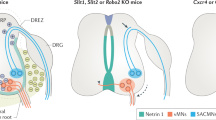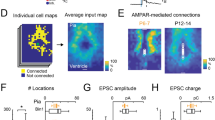Abstract
Modifying serotonin (5-HT) abundance in the embryonic mouse brain disrupts the precision of sensory maps formed by thalamocortical axons (TCAs), suggesting that 5-HT influences their growth. We investigated the mechanism by which 5-HT influences TCAs during development. 5-HT1B and 5-HT1D receptor expression in the fetal forebrain overlaps with that of the axon guidance receptors DCC and Unc5c. In coculture assays, axons originating from anterior and posterior halves of the embryonic day 14.5 dorsal thalamus responded differently to netrin-1, reflecting the patterns of DCC and Unc5c expression. 5-HT converts the attraction exerted by netrin-1 on posterior TCAs to repulsion. Pharmacological manipulation of 5-HT1B/1D receptors and intracellular cAMP showed the signaling cascade through which this modulation occurs. An in vivo correlate of altered TCA pathfinding was obtained by transient manipulation of 5-HT1B/1D receptor expression abundance in the dorsal thalamus by in utero electroporation. These data demonstrate that serotonergic signaling has a previously unrecognized role in the modulation of axonal responsiveness to a classic guidance cue.
This is a preview of subscription content, access via your institution
Access options
Subscribe to this journal
Receive 12 print issues and online access
$209.00 per year
only $17.42 per issue
Buy this article
- Purchase on Springer Link
- Instant access to full article PDF
Prices may be subject to local taxes which are calculated during checkout








Similar content being viewed by others
Accession codes
References
Rehn, A.E. & Rees, S.M. Investigating the neurodevelopmental hypothesis of schizophrenia. Clin. Exp. Pharmacol. Physiol. 32, 687–696 (2005).
Persico, A.M. & Bourgeron, T. Searching for ways out of the autism maze: genetic, epigenetic and environmental clues. Trends Neurosci. 29, 349–358 (2006).
Gross, C. et al. Serotonin1A receptor acts during development to establish normal anxiety-like behaviour in the adult. Nature 416, 396–400 (2002).
Ansorge, M.S., Zhou, M., Lira, A., Hen, R. & Gingrich, J.A. Early-life blockade of the 5-HT transporter alters emotional behavior in adult mice. Science 306, 879–881 (2004).
Haydon, P.G., McCobb, D.P. & Kater, S.B. Serotonin selectively inhibits growth cone motility and synaptogenesis of specific identified neurons. Science 226, 561–564 (1984).
Whitaker-Azmitia, P.M., Druse, M., Walker, P. & Lauder, J.M. Serotonin as a developmental signal. Behav. Brain Res. 73, 19–29 (1996).
Vitalis, T. & Parnavelas, J.G. The role of serotonin in early cortical development. Dev. Neurosci. 25, 245–256 (2003).
Persico, A.M., Di Pino, G. & Levitt, P. Multiple receptors mediate the trophic effects of serotonin on ventroposterior thalamic neurons in vitro. Brain Res. 1095, 17–25 (2006).
Janusonis, S., Gluncic, V. & Rakic, P. Early serotonergic projections to Cajal-Retzius cells: relevance for cortical development. J. Neurosci. 24, 1652–1659 (2004).
Cases, O. et al. Lack of barrels in the somatosensory cortex of monoamine oxidase A–deficient mice: role of a serotonin excess during the critical period. Neuron 16, 297–307 (1996).
Persico, A.M. et al. Barrel pattern formation requires serotonin uptake by thalamocortical afferents, and not vesicular monoamine release. J. Neurosci. 21, 6862–6873 (2001).
Bonnin, A., Peng, W., Hewlett, W. & Levitt, P. Expression mapping of 5-HT1 serotonin receptor subtypes during fetal and early postnatal mouse forebrain development. Neuroscience 141, 781–794 (2006).
Braisted, J.E. et al. Netrin-1 promotes thalamic axon growth and is required for proper development of the thalamocortical projection. J. Neurosci. 20, 5792–5801 (2000).
Garel, S. & Rubenstein, J.L. Intermediate targets in formation of topographic projections: inputs from the thalamocortical system. Trends Neurosci. 27, 533–539 (2004).
Adham, N., Romanienko, P., Hartig, P., Weinshank, R.L. & Branchek, T. The rat 5-hydroxytryptamine1B receptor is the species homologue of the human 5-hydroxytryptamine1D beta receptor. Mol. Pharmacol. 41, 1–7 (1992).
Hamblin, M.W. & Metcalf, M.A. Primary structure and functional characterization of a human 5-HT1D–type serotonin receptor. Mol. Pharmacol. 40, 143–148 (1991).
Ming, G.L. et al. cAMP-dependent growth cone guidance by netrin-1. Neuron 19, 1225–1235 (1997).
Song, H.J., Ming, G.L. & Poo, M.M. cAMP-induced switching in turning direction of nerve growth cones. Nature 388, 275–279 (1997).
Hopker, V.H., Shewan, D., Tessier-Lavigne, M., Poo, M. & Holt, C. Growth-cone attraction to netrin-1 is converted to repulsion by laminin-1. Nature 401, 69–73 (1999).
Nishiyama, M. et al. Cyclic AMP/GMP–dependent modulation of Ca2+ channels sets the polarity of nerve growth-cone turning. Nature 423, 990–995 (2003).
Lopez-Bendito, G. & Molnar, Z. Thalamocortical development: how are we going to get there? Nat. Rev. Neurosci. 4, 276–289 (2003).
Marillat, V. et al. Spatiotemporal expression patterns of slit and robo genes in the rat brain. J. Comp. Neurol. 442, 130–155 (2002).
Miyashita-Lin, E.M., Hevner, R., Wassarman, K.M., Martinez, S. & Rubenstein, J.L. Early neocortical regionalization in the absence of thalamic innervation. Science 285, 906–909 (1999).
Gad, J.M., Keeling, S.L., Wilks, A.F., Tan, S.S. & Cooper, H.M. The expression patterns of guidance receptors, DCC and Neogenin, are spatially and temporally distinct throughout mouse embryogenesis. Dev. Biol. 192, 258–273 (1997).
Przyborski, S.A., Knowles, B.B. & Ackerman, S.L. Embryonic phenotype of Unc5h3 mutant mice suggests chemorepulsion during the formation of the rostral cerebellar boundary. Development 125, 41–50 (1998).
Li, H.S. et al. Vertebrate slit, a secreted ligand for the transmembrane protein roundabout, is a repellent for olfactory bulb axons. Cell 96, 807–818 (1999).
Liu, G. et al. Netrin requires focal adhesion kinase and Src family kinases for axon outgrowth and attraction. Nat. Neurosci. 7, 1222–1232 (2004).
Round, J. & Stein, E. Netrin signaling leading to directed growth cone steering. Curr. Opin. Neurobiol. 17, 15–21 (2007).
Lotto, B., Upton, L., Price, D.J. & Gaspar, P. Serotonin receptor activation enhances neurite outgrowth of thalamic neurones in rodents. Neurosci. Lett. 269, 87–90 (1999).
Geerts, I.S., Matthys, K.E., Herman, A.G. & Bult, H. Involvement of 5-HT1B receptors in collar-induced hypersensitivity to 5-hydroxytryptamine of the rabbit carotid artery. Br. J. Pharmacol. 127, 1327–1336 (1999).
Price, G.W. et al. SB-216641 and BRL-15572–compounds to pharmacologically discriminate h5-HT1B and h5-HT1D receptors. Naunyn Schmiedebergs Arch. Pharmacol. 356, 312–320 (1997).
Rothermel, J.D. & Parker Botelho, L.H. A mechanistic and kinetic analysis of the interactions of the diastereoisomers of adenosine 3′,5′-(cyclic)phosphorothioate with purified cyclic AMP-dependent protein kinase. Biochem. J. 251, 757–762 (1988).
Torii, M. & Levitt, P. Dissociation of corticothalamic and thalamocortical axon targeting by an EphA7-mediated mechanism. Neuron 48, 563–575 (2005).
Nakashiba, T. et al. Netrin-G1: a novel glycosyl phosphatidylinositol-linked mammalian netrin that is functionally divergent from classical netrins. J. Neurosci. 20, 6540–6550 (2000).
Auladell, C., Perez-Sust, P., Super, H. & Soriano, E. The early development of thalamocortical and corticothalamic projections in the mouse. Anat. Embryol. (Berl.) 201, 169–179 (2000).
Molnar, Z. & Blakemore, C. How do thalamic axons find their way to the cortex? Trends Neurosci. 18, 389–397 (1995).
Wiencken-Barger, A.E., Mavity-Hudson, J., Bartsch, U., Schachner, M. & Casagrande, V.A. The role of L1 in axon pathfinding and fasciculation. Cereb. Cortex 14, 121–131 (2004).
Vanderhaeghen, P. & Polleux, F. Developmental mechanisms patterning thalamocortical projections: intrinsic, extrinsic and in between. Trends Neurosci. 27, 384–391 (2004).
Seibt, J. et al. Neurogenin2 specifies the connectivity of thalamic neurons by controlling axon responsiveness to intermediate target cues. Neuron 39, 439–452 (2003).
Crandall, J.E. & Caviness, V.S., Jr. Thalamocortical connections in newborn mice. J. Comp. Neurol. 228, 542–556 (1984).
Garel, S., Yun, K., Grosschedl, R. & Rubenstein, J.L. The early topography of thalamocortical projections is shifted in Ebf1 and Dlx1/2 mutant mice. Development 129, 5621–5634 (2002).
Molnar, Z., Adams, R. & Blakemore, C. Mechanisms underlying the early establishment of thalamocortical connections in the rat. J. Neurosci. 18, 5723–5745 (1998).
Bruns, D., Riedel, D., Klingauf, J. & Jahn, R. Quantal release of serotonin. Neuron 28, 205–220 (2000).
Clements, J.D. Transmitter timecourse in the synaptic cleft: its role in central synaptic function. Trends Neurosci. 19, 163–171 (1996).
Bouchard, J.F. et al. Protein kinase A activation promotes plasma membrane insertion of DCC from an intracellular pool: a novel mechanism regulating commissural axon extension. J. Neurosci. 24, 3040–3050 (2004).
Kreibich, T.A., Chalasani, S.H. & Raper, J.A. The neurotransmitter glutamate reduces axonal responsiveness to multiple repellents through the activation of metabotropic glutamate receptor 1. J. Neurosci. 24, 7085–7095 (2004).
Aitken, A.R. & Tork, I. Early development of serotonin-containing neurons and pathways as seen in wholemount preparations of the fetal rat brain. J. Comp. Neurol. 274, 32–47 (1988).
Puelles, L. & Rubenstein, J.L. Forebrain gene expression domains and the evolving prosomeric model. Trends Neurosci. 26, 469–476 (2003).
Fan, C.M. & Tessier-Lavigne, M. Patterning of mammalian somites by surface ectoderm and notochord: evidence for sclerotome induction by a hedgehog homolog. Cell 79, 1175–1186 (1994).
Acknowledgements
We thank J. Wu and H.H. Wu for technical help and comments, and K.L. Eagleson and G. Stanwood for comments on the manuscript. The work was supported in part by US National Institute of Mental Health grant MH65299 and US National Institute of Child Health and Human Development P30HD15052 to P.L.
Author information
Authors and Affiliations
Contributions
A.B. participated in the design of the project, the writing of the manuscript and conducted and analyzed the experiments. M.T. conducted and participated in the analyses of crucial in utero electroporation experiments and helped to write the manuscript. L.W. performed the statistical analyses. P.R. contributed to the in vivo experiments and helped to write the manuscript. P.L. contributed to the design of the experiments, interpretation of results and writing of the manuscript.
Corresponding author
Ethics declarations
Competing interests
The authors declare no competing financial interests.
Supplementary information
Supplementary Fig. 1
Putative 5-HT signaling in development. (PDF 496 kb)
Supplementary Fig. 2
Putative 5-HT signaling in development. (PDF 892 kb)
Supplementary Fig. 3
Quantification of netrin-G1 immunofluorescent intensity at E18.5 on the control and electroporated side of brains electroporated at E12.5. (PDF 170 kb)
Supplementary Fig. 4
Pathways of TCAs from anterior and posterior DT in horizontal sections at E14.5. (PDF 1312 kb)
Supplementary Fig. 5
Anterior-posterior positioning of TCAs in the IC is associated with their medial-lateral, rather than anterior-posterior, origin in the DT. (PDF 1262 kb)
Supplementary Fig. 6
Comparison between Gbx2 and Unc5c expression patterns in dorso-ventral series of horizontal sections through the E14.5 DT. (PDF 489 kb)
Supplementary Fig. 7
Schematic representation of TCA pathfinding. (PDF 63 kb)
Rights and permissions
About this article
Cite this article
Bonnin, A., Torii, M., Wang, L. et al. Serotonin modulates the response of embryonic thalamocortical axons to netrin-1. Nat Neurosci 10, 588–597 (2007). https://doi.org/10.1038/nn1896
Received:
Accepted:
Published:
Issue Date:
DOI: https://doi.org/10.1038/nn1896
This article is cited by
-
Overexpression of EphB6 and EphrinB2 controls soma spacing of cortical neurons in a mutual inhibitory way
Cell Death & Disease (2023)
-
Early life adversity shapes neural circuit function during sensitive postnatal developmental periods
Translational Psychiatry (2022)
-
Perinatal exposure to fluoxetine and maternal adversity affect myelin-related gene expression and epigenetic regulation in the corticolimbic circuit of juvenile rats
Neuropsychopharmacology (2022)
-
Emotional intelligence scores in children and adolescents with subclinical hypothyroidism—correlation with serum serotonin and thyroid-stimulating hormone (TSH) concentrations
Hormones (2022)
-
Serotonin functions as a bidirectional guidance molecule regulating growth cone motility
Cellular and Molecular Life Sciences (2021)



